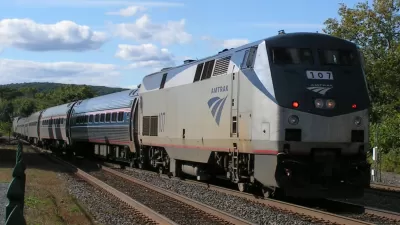States with Amtrak routes less than 750 miles (excludes lines within Northeast Corridor) will need to subsidize the budget shortfalls - the difference between fares and operating costs, or lose the route. States may cut some lines to prop-up others.

Mark Peters writes about the enactment of legislation known as the Passenger Rail Investment and Improvement Act of 2008 (PRIIA) that goes into effect this fall when the 2014 fiscal year beings. The Act requires states to pay the subsidy for shorter routes. Peters takes a closer look at its application in two states - Maine and Pennsylvania.
Maine added service between Portland and Boston a decade ago, recently extending the line farther north to Brunswick. The state supports the service itself, hiring Amtrak to run the trains, while handling marketing and food service on its own, said Patricia Quinn, executive director of the Northern New England Passenger Rail Authority.
She expects the cost shift over the next year will make states become more involved in their train service and look for ways to become more efficient. They also are likely to push Amtrak to become more efficient and could look elsewhere for certain services.
New York's Empire Corridor service, from Penn Station to Albany and Buffalo is one such example. Gov. Andrew Cuomo proposed $44 million to ensure continuation of the service.
RailwayAge's Douglas John Bowen confirms that commitment in his article on Jan. 29.
Allaying fears of cutbacks on Amtrak's Empire Corridor service linking Niagara Falls, Buffalo, Albany, and New York City, New York State says it will maintain existing Amtrak service levels with $44.3 million in state support beginning Oct. 1.
Peters indicates that the funding may prove more of a challenge in Pennsylvania, particularly with lower ridership lines in the western part of the state, including the route from Harrisburg to Pittsburgh. Residents served by that route are organizing to retain the service.
While the state likely will pick up some of the new costs to keep the same service, it will be a challenge to do so for all the routes, said Toby Fauver, deputy secretary for local and area transportation for the Pennsylvania Department of Transportation.
He said, for example, the route between Harrisburg and Pittsburgh is slower than driving and would need considerable updates to become competitive. "It is a struggle for me to want to pay for that service," Mr. Fauver said.
But the state is expected to face pushback from residents of western Pennsylvania. A ridership group held a rally last fall to start drumming up support for the route, which has stops in small towns and cities such as Altoona, Johnstown and Latrobe.
Bowen writes that Vermont and Indiana have yet to determine whether to fund the operating shortfalls for Amtrak routes in their states, and provides contrasting outlooks for rail passengers in these states.
Vermont, which already helps fund the Vermonter and Ethan Allen, is considered likely to continue financing the trains, deemed popular among state residents. By contrast, Indiana seems less likely to aid the Hoosier State, operating between Indianapolis and Chicago; rough estimates by Amtrak of the route's operating cost is between $4 million and $5 million per year.
What is clear will be new attention paid to short-distance Amtrak routes.
"It will force states who haven't paid attention to take a closer look," Ms. Quinn of the Northern New England Passenger Rail Authority said.
[Contributor's note: The link showing "subscriber-only content will be available to non-subscribers for up to seven days after (Jan. 29)"]
FULL STORY: States Weigh Picking Up Train Tab

What ‘The Brutalist’ Teaches Us About Modern Cities
How architecture and urban landscapes reflect the trauma and dysfunction of the post-war experience.

‘Complete Streets’ Webpage Deleted in Federal Purge
Basic resources and information on building bike lanes and sidewalks, formerly housed on the government’s Complete Streets website, are now gone.

The VW Bus is Back — Now as an Electric Minivan
Volkswagen’s ID. Buzz reimagines its iconic Bus as a fully electric minivan, blending retro design with modern technology, a 231-mile range, and practical versatility to offer a stylish yet functional EV for the future.

Healing Through Parks: Altadena’s Path to Recovery After the Eaton Fire
In the wake of the Eaton Fire, Altadena is uniting to restore Loma Alta Park, creating a renewed space for recreation, community gathering, and resilience.

San Diego to Rescind Multi-Unit ADU Rule
The city wants to close a loophole that allowed developers to build apartment buildings on single-family lots as ADUs.

Electric Vehicles for All? Study Finds Disparities in Access and Incentives
A new UCLA study finds that while California has made progress in electric vehicle adoption, disadvantaged communities remain underserved in EV incentives, ownership, and charging access, requiring targeted policy changes to advance equity.
Urban Design for Planners 1: Software Tools
This six-course series explores essential urban design concepts using open source software and equips planners with the tools they need to participate fully in the urban design process.
Planning for Universal Design
Learn the tools for implementing Universal Design in planning regulations.
City of Albany
UCLA Lewis Center for Regional Policy Studies
Mpact (formerly Rail~Volution)
Chaddick Institute at DePaul University
City of Piedmont, CA
Great Falls Development Authority, Inc.
HUDs Office of Policy Development and Research





























